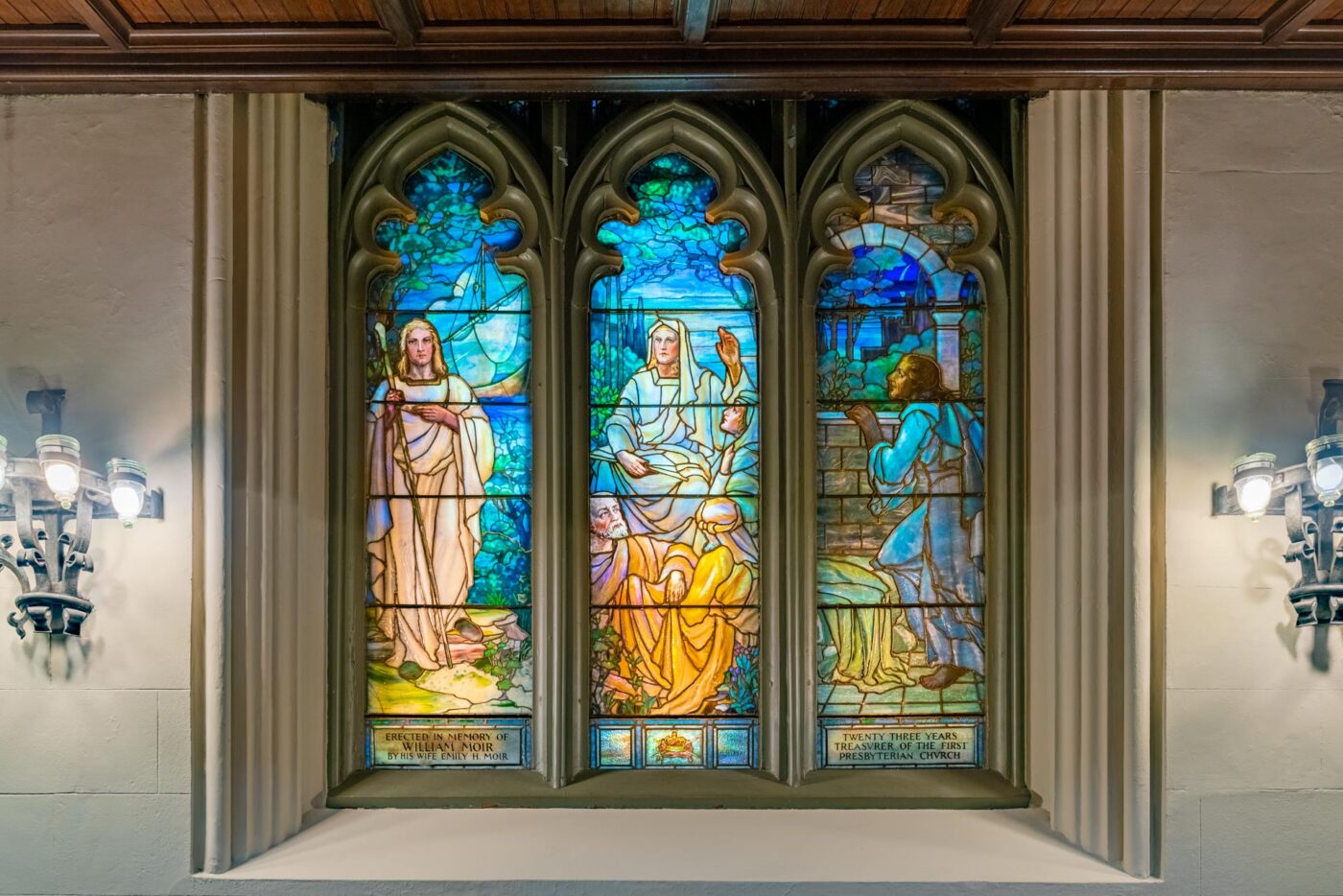Glass and the Gilded Age: Tiffany Windows in the First Presbyterian Church
Known as the Gilded Age, the period following the Civil War in late nineteenth century New York City was filled with glamour and bold, imaginative aesthetics. However, one person, and his eponymous product, may be more strongly associated with Gilded Age New York than any other — Louis Comfort Tiffany (February 18, 1848 – January 17, 1933), and his Tiffany glass. And Tiffany was not only born and raised in our neighborhoods, but left one of his most magnificent creations for the public to appreciate right here.
It is no wonder that Tiffany Studios became a household name during this era. With their stunning color and luminescence, Tiffany stained glass windows captured the eye of many newly wealthy ‘captains of industry,’ who commissioned them for their personal mansions, as well as buildings that they patronized across the city. At First Presbyterian Church, located on 12 West 12th Street, two Tiffany windows make up part of the church’s incredible interior, which also features windows by artists David Maitland Armstrong, John LeFarge, and John Lamb.

Louis Comfort Tiffany

The mastermind behind the iconic Tiffany glass was Louis Comfort Tiffany. He was born in New York City in 1848 to Harriet Olivia Avery Young and Charles Lewis Tiffany, the founder of Tiffany and Company. As a child Tiffany lived with his family at 227, 125, and 103 East 10th Street in today’s East Village. A curious designer and painter from an early age, he spent his adolescence and young adulthood learning a variety of design and fabrication techniques, but the re-emerging art of stained glass captured his imagination the most. In the 1870s he began pursuing his interest in glassmaking more seriously. While working in a series of Brooklyn glass factories, he met fellow designers Lockwood de Forest, Candace Wheeler, and Samuel Colman, who became long-term collaborators. Together they founded their own interior design firm, where they began specializing in stained glass. After several years struggling on their own, they merged with Tiffany and Co. Soon after Tiffany became the artistic director of his father’s company, making his stained glass works synonymous with the family name.
The Industrial Revolution and Art Nouveau
The Industrial Revolution made a select group of manufacturers and businessmen very wealthy, and they were eager to show off their good fortune with exuberant, ornate interior design and architecture. Aesthetically, designers were moving away from the historic revival movements that had dominated architecture in the early and mid-nineteenth century. All of these changes culminated in the Art Nouveau movement, which lasted until the early 20th century. Art Nouveau designers were inspired by organic forms and colors, and were informed by fine art traditions such as oil painting. Rapidly progressing construction technologies allowed them to bring their new ideas to fruition. Modern steel and concrete held dynamic, asymmetrical shapes that weren’t feasible before, and both the shapes and the materials could be produced with greater speed and efficiency.
The advent of Art Nouveau also brought forward a critical innovation in glassmaking. Both Louis Comfort Tiffany and his friend and rival John LeFarge are credited with the invention of opalescent glass (it was Tiffany who secured the patent, but it is highly unlikely that he was the sole inventor). At the time the standard recipe for glass included only ‘pure’ crystals that could produce the clearest glass. In their experimentation, Tiffany and other enterprising glassmakers melted cheap bottles that contained minerals and variations within the glass, resulting in marbled layers and a shine like that of an opal. They began using this technique to incorporate more colors and textures into one pane of glass, which was not possible with previous techniques in which glass was painted with enamel.
The Windows of The First Presbyterian Church


The Scotch Presbyterians, by Tiffany Studios, located on the southern wall of the church nave. Photo: The First Presbyterian Church.
The two Tiffany windows in First Presbyterian Church are part of a larger set of windows commissioned in 1893. Lining the northern and southern walls of the church, they are all beautiful examples of Art Nouveau opalescent glass. On the northern side is a portrait of the prophet Isaiah by Tiffany Studios, accompanied by other Biblical figures in the surrounding windows. The southern side features portraits of important church patrons, including one of the Scotch Presbyterians, who founded the first Presbyterian churches in New York City in the early eighteenth century.
First Presbyterian has a long history in the City, holding its first congregation in a modest meeting house on Wall Street in 1716. The church faced a number of challenges, including the Revolutionary War and the Great Fire of 1835, but the congregation persevered and eventually merged with several other Presbyterian churches in the city. They built their current Gothic Revival church on Fifth Avenue in 1846.
Want to learn more about Gilded Age New York? Check here.
